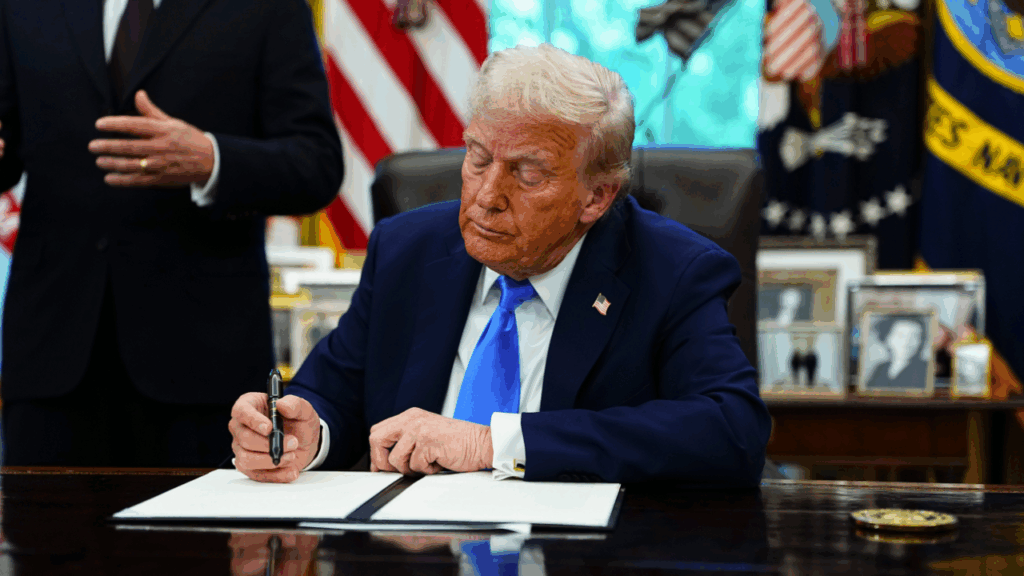The ongoing debate surrounding the H-1B visa program has been reignited following a recent proclamation by President Donald Trump. Citing concerns over job displacement among American workers, Trump has introduced a controversial $100,000 fee for companies seeking these visas, a move that has drawn significant pushback from various business leaders, especially within the technology sector. This article examines the implications of these changes, the criticisms and support surrounding the H-1B program, and the broader political landscape influencing this contentious issue.
| Article Subheadings |
|---|
| 1) Overview of the H-1B Visa Program |
| 2) Impact on Key Industries |
| 3) Public and Political Reactions |
| 4) Legislative and Regulatory Developments |
| 5) Future of the H-1B Visa Program |
Overview of the H-1B Visa Program
The H-1B visa is a non-immigrant work visa that allows U.S. employers to hire foreign workers in specialty occupations for up to six years. According to the U.S. Citizenship and Immigration Services (USCIS), this visa is intended for individuals with “exceptional merit and ability,” requiring at least a bachelor’s degree in a relevant field. The program has been crucial for American industries struggling to fill specialized positions, particularly in science, technology, engineering, and mathematics (STEM).
Impact on Key Industries
H-1B visas are predominantly utilized by the technology sector, which accounts for approximately 60% to 70% of all applications. Other industries benefiting from this visa include healthcare, engineering, and educational services. The influx of foreign talent has enabled many companies to remain competitive in an increasingly globalized market. However, with rising concerns about job displacement among American workers, the program’s perceived impact has come under scrutiny, particularly among political leaders advocating for the protection of American jobs.
Public and Political Reactions
The announcement of a new $100,000 fee for H-1B visa applications has sparked backlash from business leaders who argue that this measure could stifle innovation and job creation, particularly within small and mid-sized companies. Critics on both sides of the political spectrum, including figures like Bernie Sanders and Trump, have voiced concerns regarding potential misuse of the program. Trump’s proclamation claims that the H-1B visa program has been leveraged to replace rather than supplement American workers, warning of adverse effects on wages and job availability.
Legislative and Regulatory Developments
On the legislative front, ongoing discussions have focused on reforming the H-1B program to close loopholes that critics believe allow exploitation of foreign labor. Recent bipartisan efforts led by prominent senators aim to safeguard American jobs while still attracting top talent. At the state level, the administration of governors like Ron DeSantis is actively seeking to curb what they term “abuse” of the H-1B program by directing educational institutions to prioritize American graduates. This localized approach represents a growing effort to tackle unemployment concerns on a state level.
Future of the H-1B Visa Program
As the debate continues, the future of the H-1B program hangs in the balance. Industry groups, including the U.S. Chamber of Commerce, have pushed back against the newly imposed fee, arguing its legality and potential harm to U.S. employers. The ongoing lawsuit challenging the fee could set a precedent for how the program is managed in the future. Meanwhile, the international landscape is changing, with other countries adjusting their immigration policies to attract skilled labor in a manner that could further complicate the U.S. effort to retain talent.
| No. | Key Points |
|---|---|
| 1 | The H-1B visa program allows U.S. companies to hire skilled foreign workers for specialty occupations. |
| 2 | Tech companies utilize approximately 60% to 70% of all H-1B visas issued. |
| 3 | The introduction of a $100,000 application fee has faced heavy criticism from business leaders. |
| 4 | There is ongoing bipartisan effort to reform the program to better protect American jobs. |
| 5 | Changes in global immigration policies may impact the future competitiveness of the U.S. labor market. |
Summary
The ongoing discourse surrounding the H-1B visa program reflects deeper tensions within U.S. employment and immigration policy. While the program is essential for maintaining U.S. competitiveness in high-skilled labor markets, the introduction of new fees and calls for reform signal a significant shift in how such programs may function in the future. As stakeholders navigate these complexities, the balance between protecting American workers and fostering a robust labor market remains a critical challenge.
Frequently Asked Questions
Question: What is the purpose of the H-1B visa program?
The H-1B visa program allows U.S. employers to hire foreign workers in specialty occupations, particularly in fields that require a high degree of specialized knowledge.
Question: Why has the H-1B visa become politically contentious?
The program has drawn criticism for allegedly displacing American workers and allowing companies to pay lower wages, which has fueled debates around American job protection and immigration reform.
Question: What does the new fee for H-1B visas entail?
The new $100,000 fee for H-1B applications has been introduced to address concerns about visa abuse and to ensure that the program serves its intended purpose of supplementing the American workforce.
